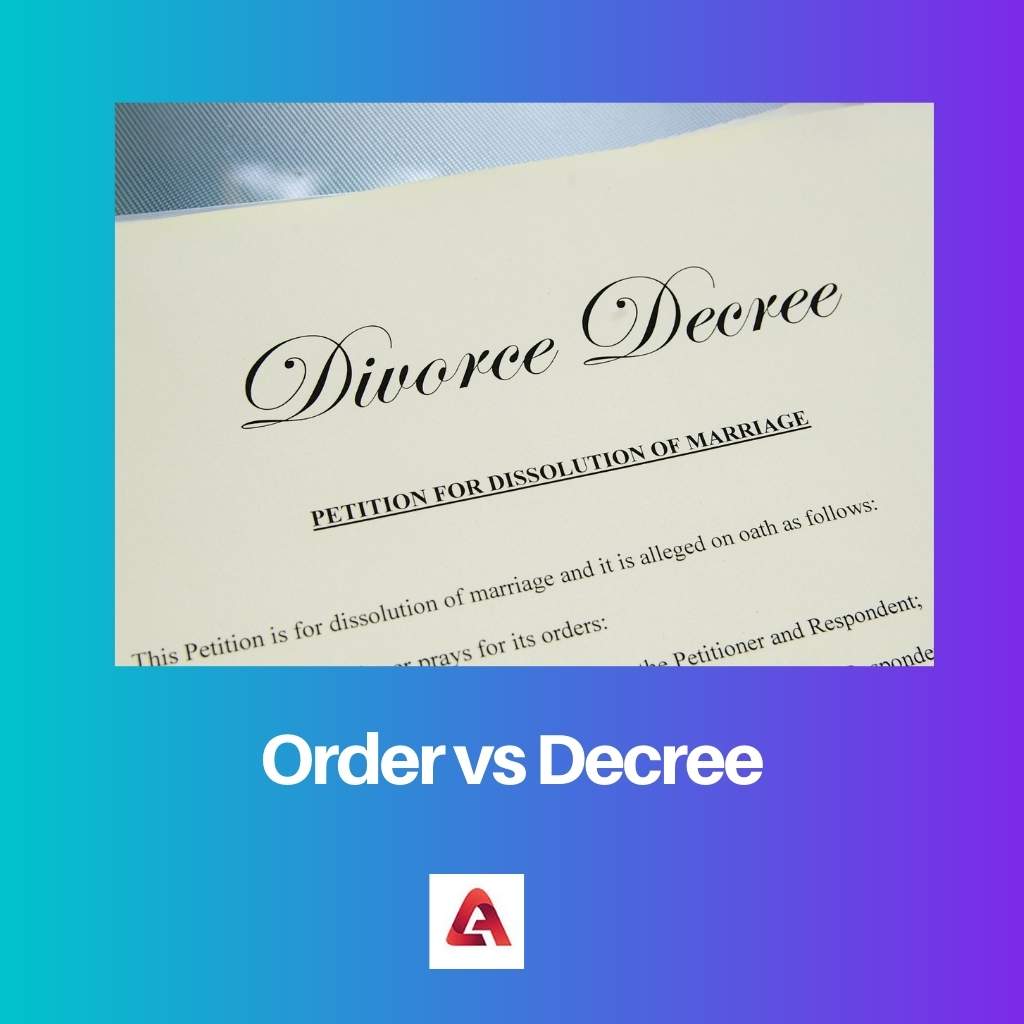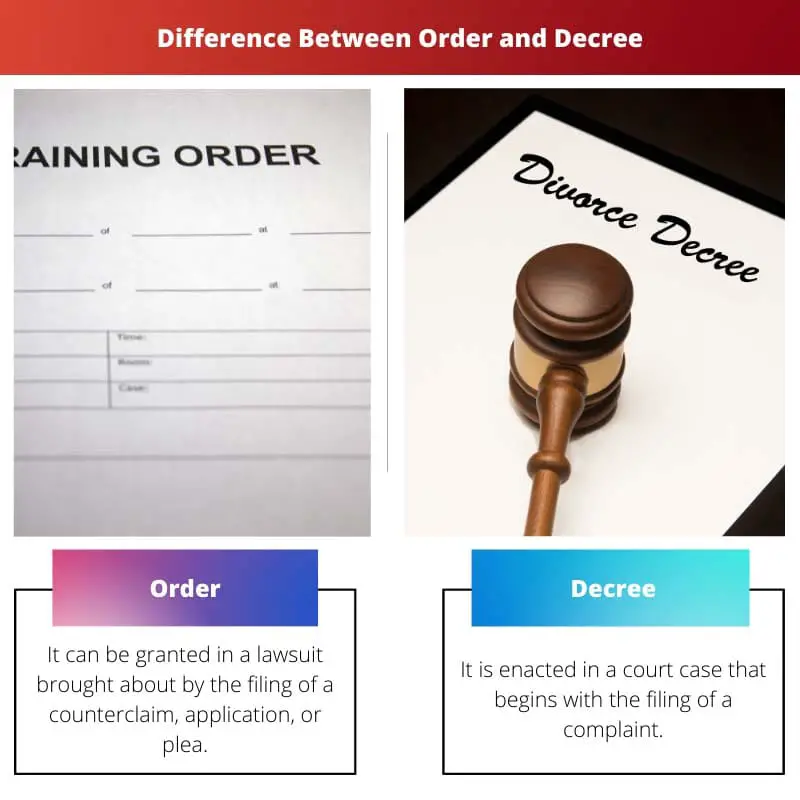Civil processes are governed by a collection of laws in the United States that establish basic rules for residents’ acts and behaviors, as well as the rules and regulations to be utilized in a court of law.
Although the two things may appear to be quite identical, there is a big variation: an ‘order’ is a ruling, a judgment based on objective factors, whereas a ‘decree’ is the final element of a judgment that deals with the rights of one (or both) of the parties to the litigation.
Key Takeaways
- An order is a command issued by a court or judge, while a decree is a formal judgment or decision.
- An order may be temporary or final, while a decree is always final.
- An order may be appealed, while the court may modify or enforce a decree.
Order vs Decree
In a court of law, an order is a written judgment given by the judge relating to the parties involved in the lawsuit. A suit may have many orders, which is not the final judgment. The decree is the single, final judgement passed on to the rights of the parties involved in a case. The judgement can be preliminary or final.

An order can be described as the legal statement of the court’s judgment that would not contain a ‘decree”, determining the legal ties between the claimant and defendant of the court hearings, trial, or appeal.
A decree, on the other hand, according to section 2(2) of the Rules of Court, is a formal declaration of a jury’s judgment that establishes the interests of the complainant in all or some subjects of the dispute.
A provisional decree is issued when one or more of the suit’s issues are addressed, whereas a final decree is issued when all of the suit’s issues are addressed.
Comparison Table
| Parameters of Comparison | Order | Decree |
|---|---|---|
| Meaning | The order, which is described in section 2(14) of the 1908 Rules Of Court, is the formal declaration of a judge’s judgement about the connection between the parties engaged in the framework of a lawsuit. | A decree is the judge’s formal pronouncement of the decision, which explains the interests of the individuals involved in the case. |
| Passed When: | It can be granted in a lawsuit brought about by the filing of a counterclaim, application, or plea. | It is enacted in a court case that begins with the filing of a complaint. |
| Type of Judgement | It’s always the last sentence. | It might be preliminary, final, or a combination of the two. |
| Formality | An order, apart from a decree, is a formal description of the court or judging panel and cannot be challenged. | A decree is a formal representation of the court, it must be presented in accordance with the proper procedure. |
| Number in a Suit | A suit can contain a large number of orders. | In a lawsuit, there is only one decree. |
What is an Order?
An order is a statement of the high court’s (or panel’s) decision and does not provide a decree (the final judgment).
To put it another way, an order is a directive from the judge to one of the parties in a lawsuit, ordering the plaintiff to perform (or not take) specified acts.
Whereas the decree deals with substantive issues, the ruling is more focused on legal technicalities. According to Section 2(14) of the 1908 Rules of Court, an ordering is “the formal statement of any Civil Court judgment that is not a decree.”
“Order” is the formal statement of any Federal Court judgment; it’s not a decree. As a result, the court’s decision, which is not a decree, is an order.
What is a Decree?
A decree is defined as “the public statement of a judgment that, so far as the Tribunal expressing it is concerned, decisively establishes the rights of the parties with respect to all or some of the facts in question in the complaint and could be either provisional or final.”
A preliminary decree may be subjected to further proceedings before the suit is concluded, but the ultimate decree, which is based on the initial decree, is issued once all of the litigation’s issues have been addressed.
There should be an assessment in order for a decree to be stated – in other words, all or indeed any portions of the matter must be decided, and the resolution of the defendant’s rights must be decisive (conclusive determination).
Order of a legal institution defining the rights of all parties to an action, as per equitable principles, in US legal use throughout the 19th and 20th centuries.
Since the Code Of Civil Procedure, which merged law and equity in federal judges in 1938, the word judgment (which has a common-law counterpart) has largely superseded decree. It’s now true throughout most state courts as well.
Main Differences Between Order and Decree
- In a court hearing, an order can never be appealed and challenged since it is directly passed on by the judge, whereas a decree is appealable and can be challenged on the basis of structured processes.
- An order can emerge from litigation initiated by the filing of a plaint or from a proceeding initiated by the filing of a plea or appeal, but a decree can only be issued in an action initiated by the filing of a plaint.

This article has been very enlightening. It’s always good to expand one’s knowledge, especially in the field of law.
The comparison between an order and a decree in this article is very well explained. Kudos to the author!
This article is a great resource for understanding the difference between court orders and decrees. It’s clear and informative.
Exactly, it’s very informative and well-structured.
The comparison table in the article provides a clear and concise understanding of the key differences between a court order and a decree.
I’m glad I came across this article. Now I have a much clearer understanding of court procedure in the US.
The explanation of order and decree in this article is both enlightening and well-explained.
I couldn’t agree more. This article offers a great overview of a complex legal topic.
Interesting read. It’s always good to know the legal distinctions in civil processes.
Definitely. It’s presented in a very structured and clear way.
Absolutely, this article offers a comprehensive insight into orders and decrees.
This article explains the complex legal concept of court orders and decrees in an easy-to-understand manner. Very helpful resource.